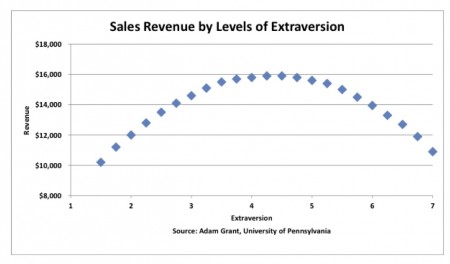Most people are familiar with personality types of extrover and introvert. While many people mistakenly think that you are one of the other, but Jung proposed that both exist in each of us, but that one is expressed more than another.
“there is no such thing as a pure extrovert or a pure introvert. Such a man would be in the lunatic asylum. They are only terms to designate…, a certain tendency….the tendency to be more influenced by environmental factors, or more influenced by the subjective factor, that’s all. There are people who are fairly well balanced and are just as much influenced from within as from without, or just as little”.
Back in the 20s, some psychologists argued for a middle of the road position they called ambivert:
Ambiverts, a term coined by social scientists in the 1920s, are people who are neither extremely introverted nor extremely extroverted. Think back to that 1-to-7 scale that Grant used. Ambiverts aren’t 1s or 2s, but they’re not 6s or 7s either. They’re 3s, 4s and 5s. They’re not quiet, but they’re not loud. They know how to assert themselves, but they’re not pushy.
Dan Pink offers a short assessment on whether you are an extrovert, introvert or ambivert.
Dan asserts that ambiverts make the best sails people:

Pink synthesizes the findings into an everyday insight for the rest of us:
The best approach is for the people on the ends to emulate those in the center. As some have noted, introverts are ‘geared to inspect,’ while extraverts are ‘geared to respond.’ Selling of any sort — whether traditional sales or non-sales selling — requires a delicate balance of inspecting and responding. Ambiverts can find that balance. They know when to speak and when to shut up. Their wider repertoires allow them to achieve harmony with a broader range of people and a more varied set of circumstances. Ambiverts are the best movers because they’re the most skilled attuners. (Cited from Brainpickings)
You can learn more about Dan’s book here:
